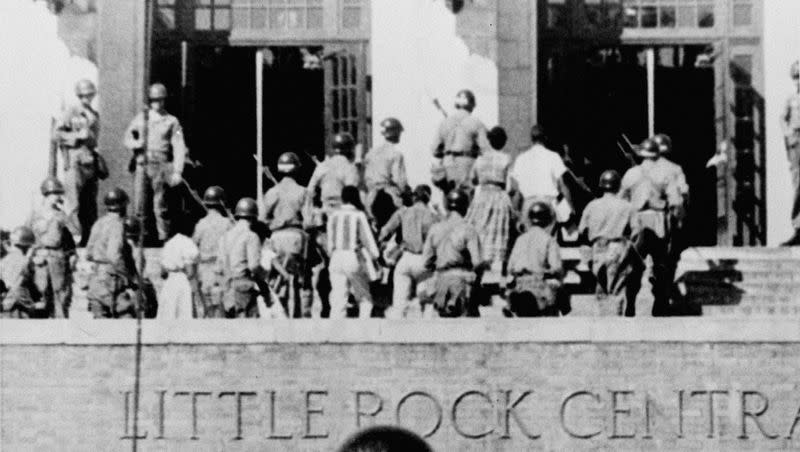On this day in history the Little Rock 9 entered school for the first time

- Oops!Something went wrong.Please try again later.
- Oops!Something went wrong.Please try again later.
- Oops!Something went wrong.Please try again later.
On the morning of Sept. 25, 1957, nine Black students, now famously called the “Little Rock Nine,” arrived at Central High School to attend their first day of school under the protection and escort from the U.S. Army’s 101st Airborne Division.
“The group — consisting of Melba Pattillo, Ernest Green, Elizabeth Eckford, Minnijean Brown, Terrence Roberts, Carlotta Walls, Jefferson Thomas, Gloria Ray, and Thelma Mothershed — became the centre of the struggle to desegregate public schools in the United States, especially in the South,” according to Britannica.
Here’s the story of how these nine students brought about an important yet deep national debate about civil rights and racial segregation.
Related
Little Rock Nine’s first attempt
The nine students first enrolled in Central High School during the summer of 1957 as permitted by the landmark Supreme Court ruling of Brown v. Board of Education in 1954 that declared segregation in public schools being “unconstitutional.”
“Until the court’s decision, many states across the nation had mandatory segregation laws, or Jim Crow laws, requiring African American and white children to attend separate schools. Resistance to the ruling was so widespread that the court issued a second decision in 1955, known as Brown II, ordering school districts to integrate ‘with all deliberate speed,’” according to History.
In response to Brown II, Daisy Bates, the local leader of the NAACP in Little Rock, Arkansas, went out and recruited the nine students to enroll and attend Central High in the fall of 1957.
The National Park Service reported that on Sept. 3, 1957, “the Little Rock Nine arrived to enter Central High School, but they were turned away by the Arkansas National Guard.”
All nine students were met with angry mobs of about 400 white civilians shouting, throwing stones and threatening to kill them along with 100 armed National Guard troops who refused to admit the students into the school.
The National Guard troops were reportedly ordered by Arkansas Gov. Orval Eugene Faubus as a follow-through on his “declared opposition to integration and his intention to defy a federal court order requiring desegregation.”
To make a terrifying situation even more intense, 15-year-old Elizabeth Eckford, one of the nine students attending school, arrived separately from the other eight students and had to face the angry mob along with the National Guard troops alone, according to Upworthy.
Eckford and the other eight students eventually left the school as their safety was threatened and their entrance was being blocked on all sides.
The nine waited two weeks before making their second attempt.
Related
Second attempt for the Little Rock Nine
On Sept. 23, 1957, the Little Rock Nine regrouped and attempted to enter Central High School for a second time.
CGTN America reported that the nine students all coordinated to enter the school at the same place and time with a police escort to help them get through without being attacked by the angry mob.
As the students were being escorted into the school, the rioting outside got so intense that the police ultimately decided to remove the nine in order to keep them safe, according to the National Park Service.
The Eisenhower Presidential Library reported that the news coverage of this riot made its way to President Dwight D. Eisenhower, who decided to order the U.S. Army’s 101st Airborne Division to go to Arkansas and ensure the safety of the students on their third attempt.
Eisenhower reportedly said in a televised address to the nation, “Mob rule cannot be allowed to override the decisions of the courts.”
Related
The Little Rock Nine’s first official day of school
On Sept. 25, 1957, with the president’s protection through the U.S. Army’s 101st Airborne Division, the nine students were able to make it into school and officially have their first day of classes, according to History.
Though the students were finally permitted to enter the school, harassment for the nine students continued for the rest of the school year, both inside the school’s walls and within the community, according to the Eastern Illinois University Library.
Britannica reported that “one of the students, Minnijean Brown, fought back and was expelled. The remaining eight students, however, attended the school for the rest of the academic year.”
The first of the Little Rock Nine to graduate was Ernest Green, “who made history on May 27, 1958, when he became the first African American to graduate from Little Rock Central High School.”
When Faubus was reelected in 1958, he made the decision to close all of Little Rock’s schools rather than allow desegregation, which set the precedent for many Southern school districts up until 1960, when the school opened with a desgregated student body.

